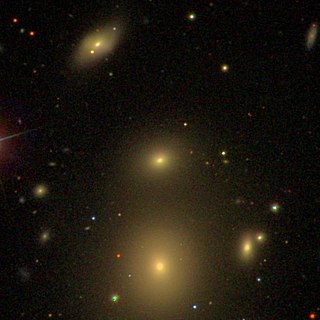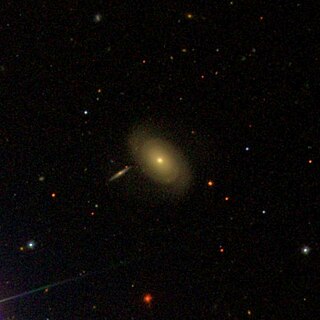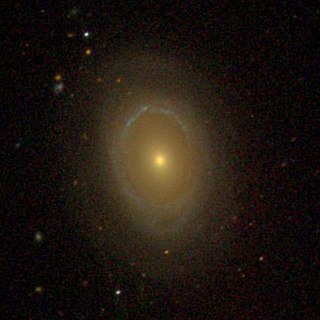
NGC 1283 is an elliptical galaxy located about 250 million light-years away in the constellation Perseus. The galaxy was discovered by astronomer Guillaume Bigourdan on October 23, 1884 and is a member of the Perseus Cluster. It also contains an active galactic nucleus.

NGC 1293 is an elliptical galaxy located about 215 million light-years away in the constellation Perseus. It was discovered by astronomer William Herschel on October 17, 1786. NGC 1293 is a member of the Perseus Cluster.

NGC 3805 is a lenticular galaxy located about 330 million light-years away in the constellation Leo. The galaxy was discovered by astronomer William Herschel on April 25, 1785. NGC 3805 is a member of the Leo Cluster.

NGC 3816 is a lenticular galaxy located about 270 million light-years away in the constellation Leo. It was discovered by astronomer Heinrich d'Arrest on May 9, 1864. NGC 3816 is a member of the Leo Cluster.

NGC 3837 is an elliptical galaxy located about 290 million light-years away in the constellation Leo. It was discovered by astronomer William Herschel on April 26, 1785. NGC 3837 is a member of the Leo Cluster.

NGC 3840 is a spiral galaxy located about 320 million light-years away in the constellation Leo. The galaxy was discovered by astronomer Heinrich d'Arrest on May 8, 1864. NGC 3840 is a member of the Leo Cluster. The galaxy is rich in neutral atomic hydrogen and is not interacting with its environment.

NGC 3841 is an elliptical or lenticular galaxy located about 300 million light-years away in the constellation Leo. It was discovered by astronomer John Herschel on March 25, 1827 is a member of the Leo Cluster.

NGC 3845 is a barred lenticular galaxy located about 270 million light-years away in the constellation Leo. NGC 3845 was discovered by astronomer John Herschel on March 17, 1831. It is a member of the Leo Cluster and is likely to be a low-luminosity AGN (LLAGN).

NGC 3851 is an elliptical or lenticular galaxy located about 300 million light-years away in the constellation Leo. It was discovered by astronomer John Herschel on February 24, 1827 and is a member of the Leo Cluster.

NGC 3857 is a lenticular galaxy located about 295 million light-years away in the constellation Leo. The galaxy was discovered by astronomer by Édouard Stephan on March 23, 1884. It is a member of the Leo Cluster.

NGC 3860 is a spiral galaxy located about 340 million light-years away in the constellation Leo. NGC 3860 was discovered by astronomer William Herschel on April 27, 1785. The galaxy is a member of the Leo Cluster and is a low-luminosity AGN (LLAGN). Gavazzi et al. however classified NGC 3860 as a strong AGN which may have been triggered by a supermassive black hole in the center of the galaxy.

NGC 3861 is a large barred spiral galaxy with a ring-like structure located about 310 million light-years away in the constellation Leo. It was discovered by astronomer John Herschel on March 23, 1827. NGC 3861 is a member of the Leo Cluster and has a normal amount of neutral hydrogen and ionised hydrogen.

NGC 4207 is a spiral galaxy located about 50 million light-years away in the constellation Virgo. The galaxy was discovered by astronomer Heinrich d'Arrest on March 23, 1865. NGC 4207 is a member of the Virgo Cluster.

NGC 3864 is a spiral galaxy located about 330 million light-years away in the constellation Leo. The galaxy was discovered by astronomer Édouard Stephan on March 23, 1884. It is a member of the Leo Cluster.

NGC 3867 is a spiral galaxy located about 350 million light-years away in the constellation Leo. It was discovered by French astronomer Édouard Stephan on 23 March 1884, and is a member of the Leo Cluster.

NGC 3868 is a lenticular galaxy located about 300 million light-years away in the constellation Leo. NGC 3868 was discovered by astronomer Édouard Stephan on March 23, 1884. It is a member of the Leo Cluster.

NGC 3873 is an elliptical galaxy located about 300 million light-years away in the constellation Leo. The galaxy was discovered by astronomer Heinrich d'Arrest on May 8, 1864. NGC 3873 is a member of the Leo Cluster.

NGC 3875 is a lenticular galaxy located about 325 million light-years away in the constellation Leo. It was discovered by astronomer William Herschel on April 27, 1785 and is a member of the Leo Cluster.

NGC 3884 is a spiral galaxy located about 330 million light-years away in the constellation Leo. The galaxy was discovered by astronomer William Herschel on April 27, 1785 and is a member of the Leo Cluster.

NGC 3886 is a lenticular galaxy located about 280 million light-years away in the constellation Leo. It was discovered by astronomer Heinrich d'Arrest on May 9, 1864. The galaxy is a member of the Leo Cluster.




















